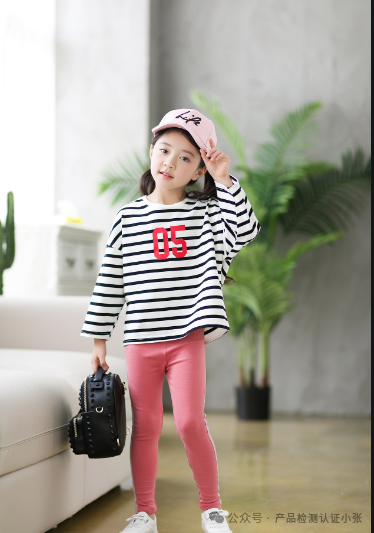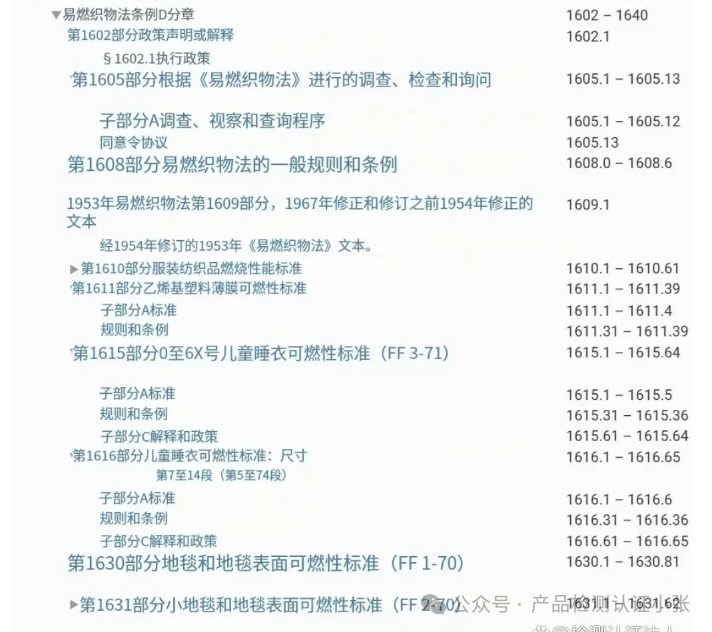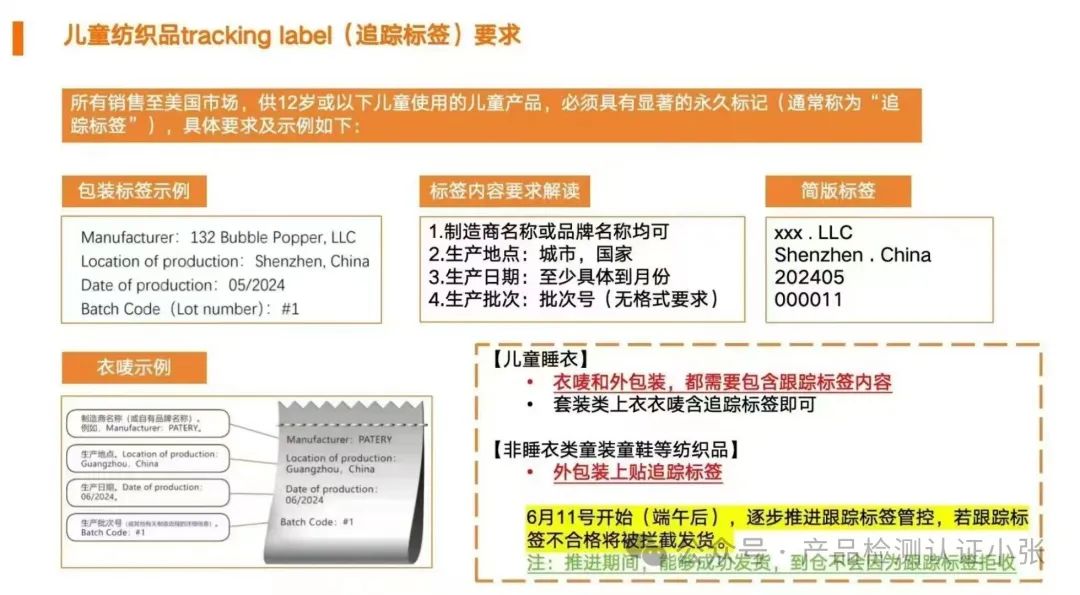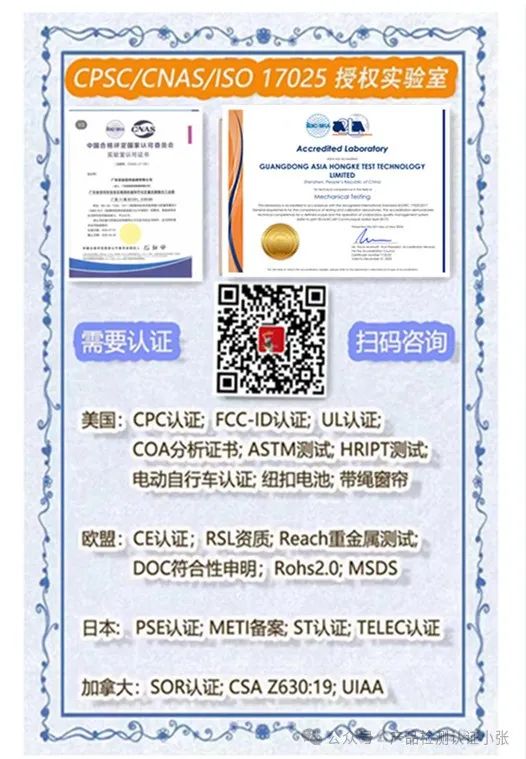Amazon US requires that all children’s toys and products must provide a Children’s Product Certificate (CPC), which is similar to a Certificate of Compliance (COC). When launching products related to children, including toys and baby products, on Amazon US, relevant test reports must be provided.
The United States passed the Flammable Fabrics Act (FFA) in 1953, which was subsequently amended in 1954 and 1967. This act was enacted by the US Congress and is enforced by the Consumer Product Safety Commission (CPSC). It primarily includes technical specifications for the flammability of textiles used in clothing and indoor furnishings, prohibiting the import, production, and sale of highly flammable textile clothing.

All of the above are mandatory technical standards in the US. All textiles and clothing sold in the US market must be tested according to these standards and meet the specified flame retardant performance requirements. Additionally, some states in the US have technical regulations regarding the flame retardant performance of textiles, such as California Technical Bulletin 117, which specifically outlines the flame retardant performance and testing methods for porous elastic materials, non-synthetic fiber filling materials, synthetic fiber filling materials, and fluffy materials.
Textiles and clothing exported to the US must comply with US clothing safety technical regulations. The Flammable Fabrics Act (FFA) specifies the flammability standards and laboratory testing methods and requirements for textiles and clothing produced and sold in the US. In 2024, the CPSC reported five clothing recall cases, all due to non-compliance with flammability standards.
Products regulated by the US clothing regulations FFA
Textile clothing, 16 CFR Part 1610
Vinyl plastic film, 16 CFR Part 1611
Children’s sleepwear, 16 CFR Parts 1615/1616
Carpets and small rugs, 16 CFR Parts 1630/1631
Mattresses and mattress pads, 16 CFR Part 1632
Complete mattress covers, 16 CFR Part 1633
Flammability standards for textile clothing 16 C.F.R. Part 1610
16 CFR Part 1610 – commonly referred to as the General Clothing Standard, implemented in the 1950s, excludes the most dangerous flammable textile products and clothing from the market.
This standard applies to all adult and children’s clothing:
Except for children’s sleepwear, which must meet stricter standards.
Not applicable to certain hats, gloves, shoes, and lining fabrics.
The standard specifies testing procedures and uses three classes of flammability to determine the relative flammability of textile clothing.
Fabrics that meet a specific exemption do not require testing.
Step 1: Confirm the type and specifications of the fabric.
Flat woven fabric or raised woven fabric.
Fabric weight.
Fiber content.
1610.1(d)—Specific exemptions.
Fabrics that meet a specific exemption do not require testing.
Flat fabrics ≥88.2 g/m2 (2.6 oz/yd2), regardless of fiber content.
Flat and raised fabrics made from the following materials: acrylic fibers, modacrylic, nylon, olefin, polyester, wool, or any combination of these fibers, regardless of weight.
16 CFR Part 1610 – Testing Summary
Initial burning must be conducted to confirm the fastest burning area and the direction of the fabric.
The fabric is tested in its original state, with 5 samples.
Test the burning time of the fastest burning direction.
Raised fabrics must be brushed to make the fibers stand up.
Level 1 and Level 2 fabrics must be reprocessed and retested, requiring another 5 samples.
All samples are dry cleaned.
All samples are washed, tumble dried for one cycle.
Average the burning times of several samples, classifying based on average burning time (burning rate) and surface characteristics of the samples (Class 1, Class 2, Class 3).
Class 3 textiles are considered to have a very high flammability hazard and are not suitable for clothing.
50 mm x 150 mm (2 inches x 6 inches) samples.
Condition requirements.
Specific testing chamber as specified.
A flame of 16 mm (5/8 inch) strikes a sample held at a 45-degree angle for one second.
Allow the sample to burn the full length or until the stop line burns through (record the burning time).
16 CFR Part 1610—Classification
Class 1: Those flat and raised fabrics without abnormal burning characteristics, suitable for use in clothing.
Class 2: Limited to raised fabrics, medium flammability, use with caution.
Class 3: Fabrics with extremely high flammability hazards, not suitable for clothing.
Common non-compliant fabrics under 16 CFR Part 1610
100% pure synthetic cotton skirts and scarves.
100% pure silk scarves.
100% rayon chenille sweaters.
Some synthetic cotton/nylon chenille and long pile sweaters.
Some polyester/cotton and 100% cotton cashmere clothing.
100% cotton towel fabric robes.
16 C.F.R. Part 1611 Vinyl plastic film.
Part of the original 1950s commercial standards of the Flammable Fabrics Act (FFA), established as 16 C.F.R. Part 1611 in 1975.
Applies to non-rigid, unsupported vinyl plastic films, including transparent, semi-transparent, and opaque materials used in clothing regulated by the Flammable Fabrics Act, such as disposable diapers and raincoats.
Clothing is tested according to Part 1610 or Part 1611.
16 CFR Parts 1615 and 1616 Flammability Standards for Children’s Sleepwear.
Children’s sleepwear has been recalled for violating US flammability standards.
The standards for children’s sleepwear, 16 CFR Parts 1615 and 1616, were established in the 1970s to address the burning issues of children’s sleepwear, such as long nightgowns, pajamas, and robes. These standards are designed to protect children from small flame sources such as matches/lighters, candles, fireplace embers, stoves, and portable heaters. These standards are not intended to protect children from large fires or fires caused by flammable liquids such as gasoline.
Children’s sleepwear refers to any clothing product primarily worn for sleeping or related activities, sized from 9 months to size 14. Long nightgowns, pajamas, robes, or similar or related items, such as indoor loungewear, are included.
Children’s sleepwear (not tight-fitting) must comply with flammability regulations. All fabrics and clothing must be flame retardant, and they must self-extinguish after being removed from small flame sources (not continue to burn). Fabrics, clothing, seams, and decorative lace must pass certain flammability tests.
16 CFR Parts 1615 and 1616 Testing Summary
The standards specify testing for fabrics, seams, and decorative lace; each test sample includes 5 samples (at least 3); each sample is placed on a metal rack and suspended vertically in the test chamber; tested in its original state and after 50 washes (if the sample passes the original state test).
Children’s sleepwear testing standards
5 samples of 8.9 cm x 25.4 cm (3.5 inches x 10 inches) fabric, seams, and decorative lace samples.
The samples are prepared before testing.
A 3.8 cm (1.5 inch) gas flame is placed at the bottom edge of the sample for three seconds.
After the flame/ember stops, measure the char length (burned area).
The average char length of the 5 samples must not exceed 17.8 cm (7.0 inches).
No single sample’s char length may exceed 25.4 cm (10.0 inches) (the entire sample length’s char).
It is required to retain the tested samples.
The standards include provisions for production testing and record retention.
Basic requirements for Amazon US:
CPC
1. The CPC certificate must be based on the results of tests conducted by a CPSC-recognized third-party testing laboratory;
2. The CPC certificate is issued by the seller, and third-party laboratories can assist in drafting the CPC certificate;
3. Children’s products must comply with all relevant safety rules and regulations;
4. Information required in the CPC certificate:
① Product information (name and description);
② All applicable regulations and rules for the product;
③ Manufacturer information: including name, address, and phone number;
④ Product production date and address, with the production date specified to the month and year, and the address specified to the city;
⑤ Testing date and address;
⑥ Information about the third-party testing agency (CPSC-recognized laboratory): name, address, and phone number.
5. Information required in the CPC certificate for normal export of children’s products to the US:
① Product information (name and description);
② All applicable regulations and rules for the product;
③ Importer or manufacturer (domestic US) information: including name, address, and phone number;
④ Contact information of the holder of the test results supporting the certificate: name, address, email address, and phone number;
⑤ Product production date and address, with the production date specified to the month and year, and the address specified to the city;
⑥ Testing date and address or the report on which the certificate is based;
⑦ Information about the third-party testing agency (CPSC-recognized laboratory): name, address, and phone number.
Note:
The Temu platform will start intercepting all children’s sleepwear and all clothing labeled as sleepwear from December 1.
Please ensure to include traceability information on the care label.
Important considerations:
– Please ensure that the English spelling follows the template exactly, do not misspell.
– English words and phrases should not be split across lines, for example, “location of production” should not be split into two lines, it must be on the same line.

